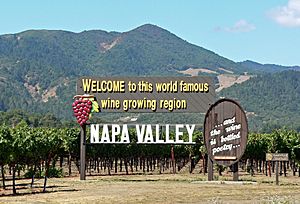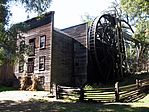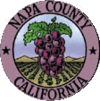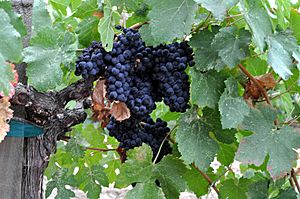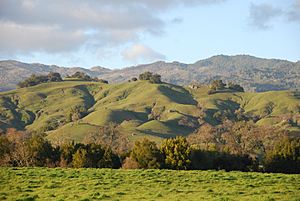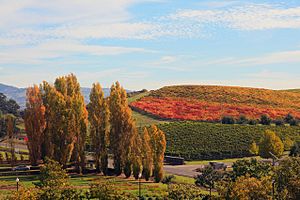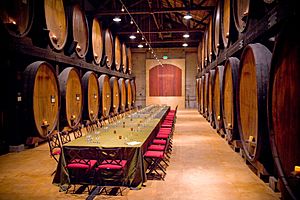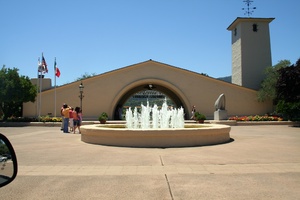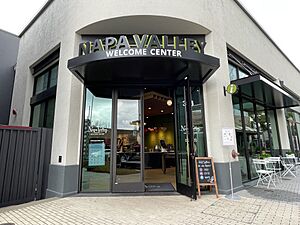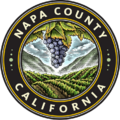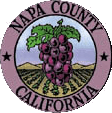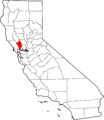Napa County, California facts for kids
Quick facts for kids
Napa County, California
|
|||
|---|---|---|---|
| County of Napa | |||
|
Images, from top down, left to right: Napa Valley welcome sign, Bale Grist Mill State Historic Park, a view of Calistoga from Mount Saint Helena, Lake Berryessa
|
|||
|
|||
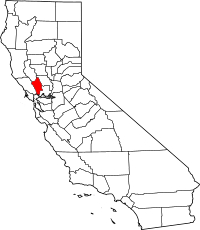
Location in the state of California
|
|||
| Country | United States | ||
| State | California | ||
| Region | San Francisco Bay Area | ||
| Founded | February 18, 1850 | ||
| Named for | The city of Napa | ||
| County seat | Napa | ||
| Largest city | Napa | ||
| Government | |||
| • Type | Council–CEO | ||
| • Body | Board of Supervisors | ||
| Area | |||
| • Total | 789 sq mi (2,040 km2) | ||
| • Land | 748 sq mi (1,940 km2) | ||
| • Water | 40 sq mi (100 km2) | ||
| Highest elevation | 4,203 ft (1,281 m) | ||
| Population
(2020)
|
|||
| • Total | 138,019 | ||
| • Density | 185/sq mi (71/km2) | ||
| GDP | |||
| • Total | $13.166 billion (2022) | ||
| Time zone | UTC−8 (Pacific Time Zone) | ||
| • Summer (DST) | UTC−7 (Pacific Daylight Time) | ||
| Area code | 707 | ||
| FIPS code | 06-055 | ||
| GNIS feature ID | 277292 | ||
Napa County (![]() i/ˈnæpə/) is a county in northern California. It is located north of San Pablo Bay. In 2020, about 138,019 people lived there. The main city and county seat is Napa.
i/ˈnæpə/) is a county in northern California. It is located north of San Pablo Bay. In 2020, about 138,019 people lived there. The main city and county seat is Napa.
Napa County was one of California's first counties. It was created in 1850 when California became a state. Later, some of its land was given to Lake County in 1861.
Today, Napa County is famous for its wine industry. It became a top wine region in 1976. This happened when local wineries won a famous wine competition in Paris, France.
Contents
History of Napa County
Early Days: Before the 1800s
Long ago, the Patwin Native American people lived in the Napa Valley. They built villages near rivers. They ate wild roots, acorns, small animals, and even grasshoppers. In winter, they lived in huts made of tree branches. In summer, they camped by streams.
In 1776, Spanish Governor Felipe de Neve built a fort near Napa. Later, in the early 1800s, Russians from Sonoma County's Fort Ross brought cattle and sheep to graze in the valley.
The 1800s: Settlers Arrive
In 1823, Francis Castro and Father Jose Altimura were the first Europeans to explore Napa Valley. When the first white settlers arrived in the 1830s, there were six Native American tribes living in the valley. Many native people died in a smallpox outbreak in 1838. Some were also killed by settlers.
Between 1836 and 1846, California was part of independent Mexico. During this time, 13 large land grants called ranchos were given out in Napa County.
- Carne Humana
- Catacula
- Caymus
- Chimiles
- Entre Napa
- Huichica
- La Jota
- Las Putas
- Locoallomi
- Mallacomes
- Napa
- Tulucay
- Yajome
George C. Yount was one of the first English-speaking settlers in Napa County. In 1836, he received the Rancho Caymus land grant. He built the first log house in California and planted the first vineyard in the county. The town of Yountville is named after him.
Edward Turner Bale was granted Rancho Carne Humana. He built the Bale Grist Mill in 1846. The town of Napa was founded by Nathan Coombs in 1847.
After the Mexican–American War and the Mexican Cession in 1848, settlers received deeds to these ranchos. Many streets and landmarks in the valley still have names from these early land grants.
Late 1800s: Growth and Change
Napa County became one of California's original counties in 1850. This was when California joined the United States.
Early settlers like George Yount and Edward Bale had a big impact. Yount's granddaughter married Thomas Rutherford. They received land where the town of Rutherford is now. Rutherford became a successful wine grower. Edward Bale's daughter, Caroline, married Charles Krug. Krug started the valley's first commercial winery in 1861.
John Patchett opened the first commercial winery in Napa County in 1859.
The county's population grew as pioneers and business people moved in. They raised cattle and grew grain and fruit. Mining was also important. In 1858, a silver rush began in the eastern hills. Napa County became a center for silver and quicksilver mining in the 1860s.
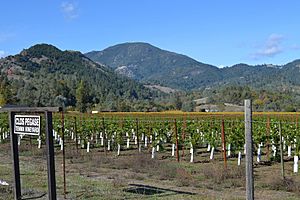
The writer Robert Louis Stevenson wrote a book called The Silverado Squatters. It describes life in Napa Valley in the late 1800s. Stevenson and his family spent time at an old mine near Mount Saint Helena. His book also made the county's spas and hot springs popular. Tourists from San Francisco loved to visit to escape the cold weather.
In the mid-1860s, Samuel Brannan bought land and founded Calistoga. He developed it as a resort town because of its many hot springs. He also started the Napa Valley Railroad to bring tourists from San Francisco.
The Veterans Home of California Yountville was built in Yountville in 1884. It was a home for veterans.
The 1900s and Beyond
By the late 1800s, farmers had planted many fruit and nut trees, like plums and pears. This helped the economy when a bug called phylloxera damaged vineyards. It also helped during Prohibition, which made it illegal to sell alcohol. During Prohibition, many wineries closed. But farmers could still ship grapes to people who made wine at home.
During World War II, the Basalt Rock Company in Napa built rescue tugs for the United States Navy. German prisoners of war were housed near Yountville. They helped with farm work because many American workers were away fighting in the war.
After the war, the wine industry in Napa grew again. In 1965, Robert Mondavi started his own winery. It was the first big new winery since Prohibition. This helped Napa Valley become famous for its wines.
On August 24, 2014, a magnitude 6.0 earthquake hit the area. In October 2017, wildfires affected parts of the county. More fires, like the County Fire in 2018 and the Kincade Fire in 2019, also impacted Napa County.
Geography
Napa County covers about 789 square miles. About 748 square miles are land, and 40 square miles are water.
Napa has warmer summers than Sonoma County to the west. This is why Napa wineries often grow grapes like Cabernet Sauvignon. Wineries in Sonoma and Santa Barbara often grow Pinot noir and Chardonnay.
Mount Saint Helena is in the northern part of Napa County. It is the second tallest peak in the Bay Area, at 4,344 feet. Robert Louis Stevenson State Park is also there. Napa County is home to many plants and animals, including some rare ones.
Neighboring Counties
- Lake County (northwest)
- Yolo County (northeast)
- Solano County (east)
- Sonoma County (west)
Protected Areas
Rivers and Creeks
Lakes, Marshes, and Reservoirs
- East Napa Reservoir
- East Side Reservoir
- Fiege Reservoir
- Lake Berryessa
- Lake Hennessey
- Lake Marie
- Lake Orville
- Lake Whitehead
- Milliken Reservoir
- Napa Sonoma Marsh
- Rector Reservoir
- West Napa Reservoir
Population Information
The 2020 census showed that Napa County had 138,019 people.
| Race / Ethnicity (NH = Non-Hispanic) | Pop 2000 | Pop 2010 | Pop 2020 | % 2000 | % 2010 | % 2020 |
|---|---|---|---|---|---|---|
| White alone (NH) | 85,932 | 76,967 | 68,909 | 69.14% | 56.39% | 49.93% |
| Black or African American alone (NH) | 1,527 | 2,440 | 2,300 | 1.23% | 1.79% | 1.67% |
| Native American or Alaska Native alone (NH) | 642 | 544 | 507 | 0.52% | 0.40% | 0.37% |
| Asian alone (NH) | 3,641 | 8,986 | 10,520 | 2.93% | 6.58% | 7.62% |
| Pacific Islander alone (NH) | 254 | 313 | 316 | 0.20% | 0.23% | 0.23% |
| Other Race alone (NH) | 226 | 221 | 910 | 0.18% | 0.16% | 0.66% |
| Mixed Race or Multi-Racial (NH) | 2,641 | 3,003 | 5,728 | 2.13% | 2.20% | 4.15% |
| Hispanic or Latino (any race) | 29,416 | 44,010 | 48,829 | 23.67% | 32.25% | 35.38% |
| Total | 124,279 | 136,484 | 138,019 | 100.00% | 100.00% | 100.00% |
Economy
Napa County has a strong economy, with several important industries.
- Healthcare and Social Assistance: This is the largest employer, with over 11,000 people working in hospitals and clinics. Major employers include Kaiser Permanente and Queen of the Valley Medical Center.
- Manufacturing: This sector includes winemaking and has a very high annual payroll. There are over 500 wineries in Napa County.
- Accommodation and Food Services: Many people work in hotels, resorts, and restaurants, serving tourists. Famous places like The French Laundry are here.
- Retail Trade: This involves stores and shops, with many businesses selling goods.
- Agriculture: While seasonal, farming, especially grape growing, is very important to the county's economy.
Wine Industry
Napa Valley is known worldwide for its amazing wines. Winemaking here started in the early 1800s. By the late 1800s, there were over 140 wineries. Some of these, like Charles Krug Winery and Beringer, are still around today.
The wine industry faced big challenges. Prohibition (1920-1933) made it illegal to sell alcohol, forcing many wineries to close. Also, a tiny bug called phylloxera destroyed many grapevines.
However, some families, like the Mondavis, continued to grow and ship grapes. After Prohibition ended in 1933, the industry slowly rebuilt.
In 1965, Robert Mondavi started his own winery. This was a big step for Napa Valley. It helped bring new attention to the region. Many new wineries opened, and Napa's fame grew.
Today, Napa Valley has over 400 wineries. They grow many types of grapes, like Cabernet Sauvignon and Chardonnay. Millions of people visit the area each year to enjoy the wine and scenery.
Protecting Farmland
Napa County has worked hard to keep its farmland natural and open. Unlike some nearby counties, it has not allowed many farms to be turned into shopping centers or houses.
In 1968, leaders in the county used a law called the Williamson Act. This law helps landowners get tax breaks if they promise to keep their land for farming. Napa Valley was the first place in California to create such a large "agricultural preserve." It started with 23,000 acres and now covers over 30,000 acres.
The county has continued to protect this farmland. In 1990, voters approved a rule (Measure J) that makes it very hard to change zoning laws until 2020. This means most farmland cannot be used for other purposes.
The Land Trust of Napa County was started in 1976. This group works to protect the county's natural areas, beautiful open spaces, and farms. They now protect over 50,000 acres of land.
While residential growth has slowed in farming areas, cities within the county have continued to grow. New businesses and retail stores have opened, especially in American Canyon. American Canyon has also created its own "green belt" to protect over 1,000 acres of open land.
Education
Napa County has many public and private schools. It also has two colleges:
- Pacific Union College: A four-year college with about 1,500 students.
- Napa Valley College: A community college that offers two-year degrees.
K-12 Schools
School districts in Napa County include:
- Calistoga Joint Unified School District
- Fairfield-Suisun Unified School District
- Napa Valley Unified School District
- St. Helena Unified School District
- Howell Mountain Elementary School District
- Pope Valley Union Elementary School District
Library
The Napa County Library is the public library system. The main library is in downtown Napa. There are also branch libraries in American Canyon, Calistoga, and Yountville.
Media
Napa County has its own local media. These include:
- Napa Valley Register (newspaper)
- St. Helena Star (newspaper)
- Weekly Calistogan (newspaper)
- American Canyon Eagle (newspaper)
- Calistoga Tribune (newspaper)
- Yountville Sun (newspaper)
- Napa Valley Life (magazine)
- KVON 1440 kHz AM (radio)
- KVYN 99.3 MHz FM (radio)
Transportation
Major Highways
Public Transportation
Vine Transit runs local bus services in Napa. It also has routes that connect to other cities like Vallejo, Fairfield, and Suisun City. There are also express routes to the El Cerrito Del Norte BART station and Suisun City Amtrak.
Airports
- Napa County Airport is a general aviation airport south of Napa City.
- Angwin-Parrett Field is a public airport near Angwin.
Rail
The Napa Valley Railroad is owned by the Napa Valley Wine Train. This train offers dining and tours. Passengers ride in vintage train cars on a 36-mile round trip from Napa to St. Helena.
Events
Napa County hosts many fun events throughout the year.
- The Napa County Fair happens every July in Calistoga.
- The Napa Town and Country Fair takes place in mid-July in Napa.
- Arts in April is a month-long celebration of art and culture. It helps bring tourists during the quieter winter months.
- The Napa Valley Marathon is a running race held every March.
- The Napa Valley Wine Auction happens in June. Wineries donate wines to be auctioned off. This event raises millions of dollars for local charities.
Festival Napa Valley
Since 2006, Napa Valley has hosted the Festival Napa Valley. This is an annual festival that celebrates food, wine, art, and music. It takes place at different locations across the valley.
Napa Valley Film Festival
The Napa Valley Film Festival started in 2011. It celebrates independent films and takes place every November.
BottleRock Napa Valley
BottleRock Napa Valley is a big music festival. It first happened in May 2013 in Napa. The festival features many bands and local wineries. It is now held every year on Memorial Day weekend.
Communities
Cities
- American Canyon
- Calistoga
- Napa (county seat)
- St. Helena
- Yountville
Census-designated places
Other Communities
Population Ranking
This table shows the population of cities and towns in Napa County based on the 2010 census.
† county seat
| Rank | City/Town/etc. | Municipal type | Population (2010 Census) |
|---|---|---|---|
| 1 | † Napa | City | 76,915 |
| 2 | American Canyon | City | 19,454 |
| 3 | St. Helena | City | 5,814 |
| 4 | Calistoga | City | 5,155 |
| 5 | Angwin | CDP | 3,051 |
| 6 | Yountville | City | 2,933 |
| 7 | Deer Park | CDP | 1,267 |
| 8 | Silverado Resort | CDP | 1,095 |
| 9 | Moskowite Corner | CDP | 211 |
| 10 | Rutherford | CDP | 164 |
| 11 | Oakville | CDP | 71 |
Famous People from Napa County
- Michael Chiarello, chef
- Francis Ford Coppola, director
- Margaret Keane, artist
- Thomas Keller, chef
- Robert Mondavi, winemaker
- Gustave Niebaum, winemaker
- Warren Winiarski, winemaker and grape grower
- Robin Williams, actor
Images for kids
See also
 In Spanish: Condado de Napa para niños
In Spanish: Condado de Napa para niños


